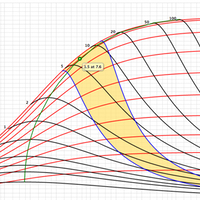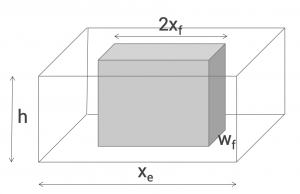Difference between revisions of "Category: OptiFrac"
(→Type Curves) |
(→Type Curves) |
||
| Line 59: | Line 59: | ||
==Type Curves== | ==Type Curves== | ||
| + | |||
| + | For finite fracture conductivities, the shape factors, '''C<sub>A</sub>''', can be calculated if the '''P<sub>D</sub>''' is known for a specific value of '''I<sub>x</sub>''' | ||
| + | The '''P<sub>D</sub>''' value could be obtained either by analytical solution or numerical simulations. After knowing ''C<sub>A</sub>''' (which would be a function of '''I<sub>x</sub>'''), “f-function” values can be calculated if PˆWD is known for a specific dimensionless fracture conductivity ''C<sub>fD</sub>''' and fracture penetration '''I<sub>x</sub>'''. | ||
| + | |||
| + | Type Curves were obtained, through seven hundred runs with a numerical simulator, modeling a fractured well in a closed square reservoir. | ||
shows the dimensionless productivity index at pseudo-steady state as function of CfD, using IX as parameter and overlapping with the type curve with NP as parameter. | shows the dimensionless productivity index at pseudo-steady state as function of CfD, using IX as parameter and overlapping with the type curve with NP as parameter. | ||
Revision as of 13:55, 14 August 2018
Contents
Brief
optiFrac is a single well fracture design optimization tool.
For the given set of reservoir and proppant properties optiFrac calculates maximum achievable well productivity index (JD) and required fracture geometry.
In production optimization of hydraulic fracturing, it is important to recognize that for a fixed proppant volume, fracture length and fracture width compete to each other. Consequently, there is an optimum fracture length and width that would maximize the dimensionless productivity index of the fractured well [1]. Unified Fracture Design provides a methodology whereby for any given proppant volume the best combination of width and length could be determined [2].
optiFrac is available online at www.pengtools.com and in AppStore for iPad.
Typical applications
- Optimization of hydraulic fracturing with Unified Fracture Design[2]
- Understanding post-fracturing production performance
- Design Sensitivity Studies and Benchmarking
- Optimum fracture design parameters determination:
- Dimensionless productivity index, JD .
- Dimensionless Fracture conductivity, CfD .
- Fracture half length, Xf .
- Fracture width, w .
- Fracture penetration, Ix .
Main features
- Plot of JD as a function of CfD and Ix as parameter.
- Plot of JD as a function of CfD and Np as parameter.
- Design optimization curve which corresponds to the maximum JD values for different Np.
- Design Optimum Point at which the dimensionless productivity index, JD, is maximized for the given proppant, fracture and reservoir parameters.
- Physical constraints envelope.
- Proppant library with predefined proppant properties.
- Users Data Worksheet for benchmarking vs actual.
Interface features
- Save and share models with colleagues
- Last saved model on current computer and browser is automatically opened
- Metric and US oilfield units
- Save as image and print plots by means of chart context menu (button at the upper-right corner of chart)
- Download pdf report with input parameters, calculated values and plots
- Select and copy results to Excel or other applications
Math & Physics
 - penetration ratio [2],
- penetration ratio [2],
 - dimensionless fracture conductivity [2],
- dimensionless fracture conductivity [2],
 - proppant numer [2],
- proppant numer [2],
 - pseudo-steady state equation for finite-conductivity fractured wells [1],
- pseudo-steady state equation for finite-conductivity fractured wells [1],
 - steady state equation for finite-conductivity fractured wells [1],
- steady state equation for finite-conductivity fractured wells [1],
 - shape factor [1].
- shape factor [1].
Type Curves
For finite fracture conductivities, the shape factors, CA, can be calculated if the PD is known for a specific value of Ix The PD value could be obtained either by analytical solution or numerical simulations. After knowing CA (which would be a function of Ix), “f-function” values can be calculated if PˆWD is known for a specific dimensionless fracture conductivity CfD and fracture penetration Ix.
Type Curves were obtained, through seven hundred runs with a numerical simulator, modeling a fractured well in a closed square reservoir.
shows the dimensionless productivity index at pseudo-steady state as function of CfD, using IX as parameter and overlapping with the type curve with NP as parameter.
Workflow
Discussion
References
- ↑ 1.0 1.1 1.2 1.3 Rueda, J.I.; Mach, J.; Wolcott, D. (2004). "Pushing Fracturing Limits to Maximize Producibility in Turbidite Formations in Russia"
 (SPE-91760-MS). Society of Petroleum Engineers.
(SPE-91760-MS). Society of Petroleum Engineers.
- ↑ 2.0 2.1 2.2 2.3 2.4 Economides, Michael J.; Oligney, Ronald; Valko, Peter (2002). Unified Fracture Design: Bridging the Gap Between Theory and Practice. Alvin, Texas: Orsa Press.
Pages in category "OptiFrac"
The following 6 pages are in this category, out of 6 total.


